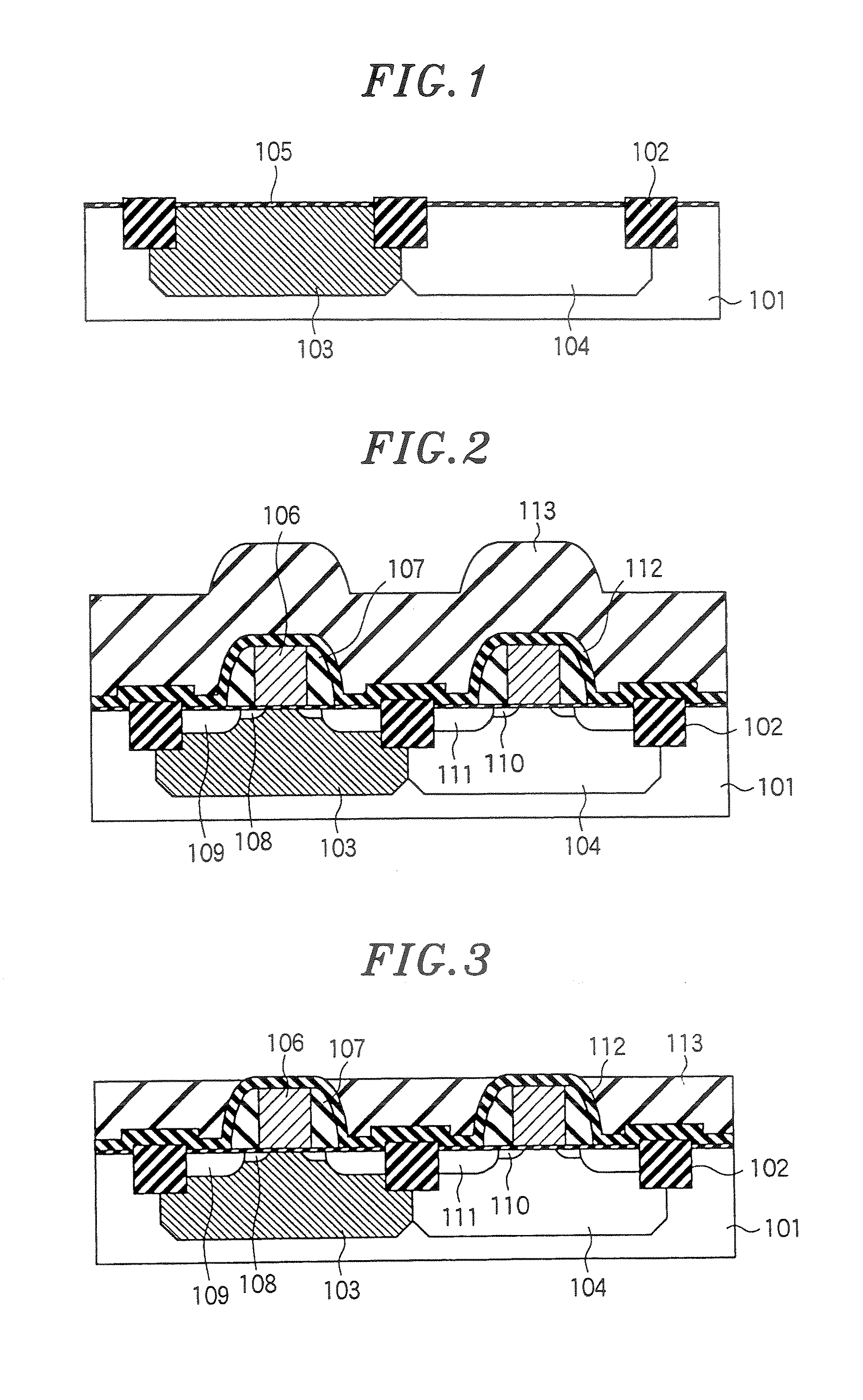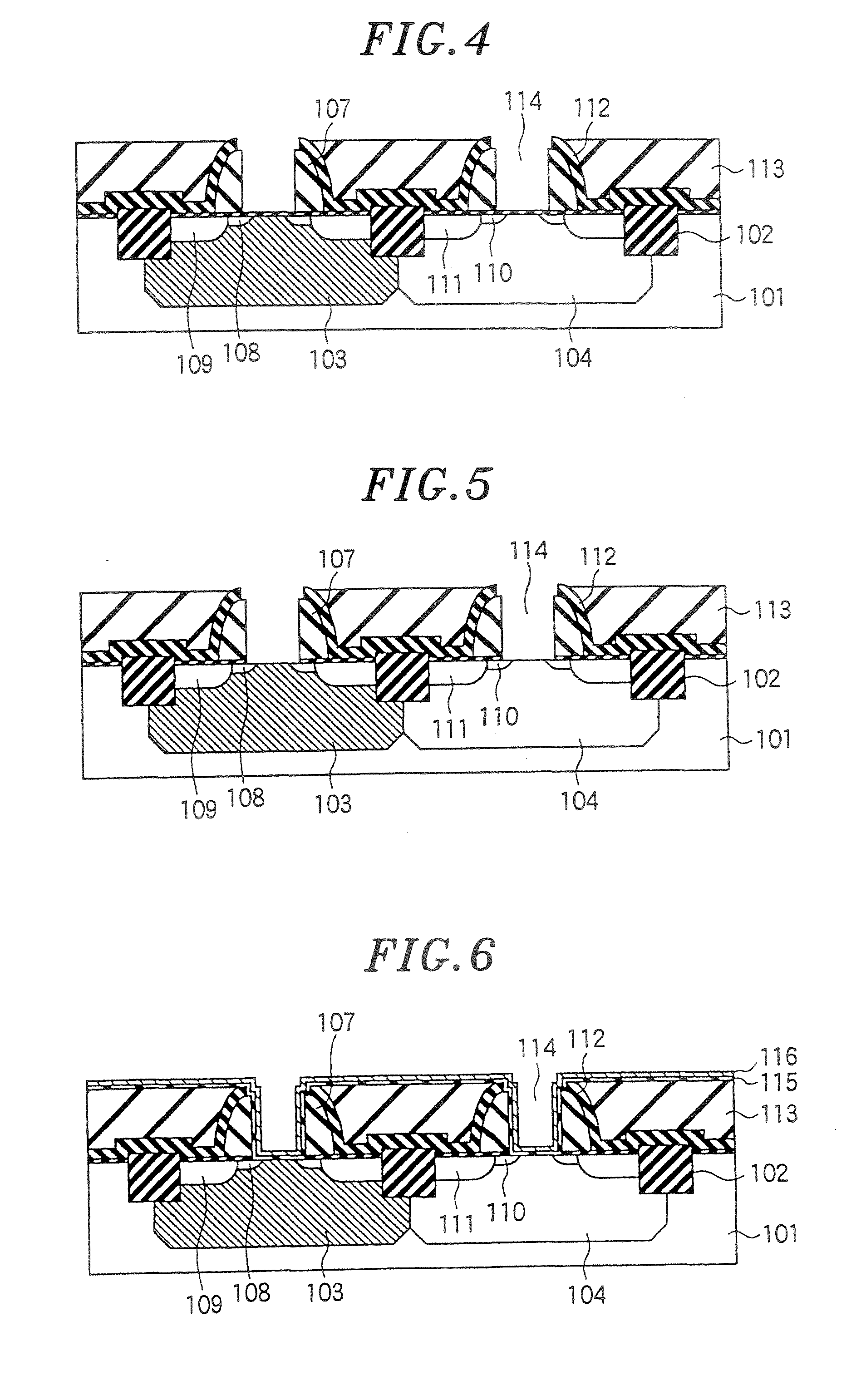Semiconductor device and manufacturing method thereof
a technology of semiconductor devices and manufacturing methods, applied in the direction of semiconductor devices, electrical devices, transistors, etc., can solve the problems of impracticality, damage to the insulating film residing below the tin film, and the technique of patent document 1 is hardly practical, so as to achieve the effect of practical level of work function differen
- Summary
- Abstract
- Description
- Claims
- Application Information
AI Technical Summary
Benefits of technology
Problems solved by technology
Method used
Image
Examples
first embodiment
[0047]A first embodiment of the present invention will be described, first.
[0048]FIGS. 1 to 11 show cross sectional views to explain a series of processes of a method in accordance with the first embodiment of the present invention.
[0049]First, device isolation regions 102, a p-type well 103 that will be an n-type MISFET region, an n-type well 104 that will be a p-type MISFET region and a silicon oxide film 105 are formed at the surface region of a semiconductor substrate 101 mainly formed of silicon, as illustrated in FIG. 1.
[0050]Next, as shown in FIG. 2, dummy gate electrodes 106 made of polycrystalline silicon or the like, gate sidewalls 107 made of an insulating film such as a silicon nitride film or the like, extensions 108 of the n-type MISFET, a source / drain regions 109 of the n-type MISFET, extensions 110 of the p-type MISFET, source / drain regions 111 of the p-type MISFET, a silicon nitride film 112 serving as a contact etching stopper and an interlayer insulating film 113 ...
second embodiment
[0064]Hereinafter, a second embodiment of the present invention will be described.
[0065]FIGS. 13 to 17 present cross sectional views to explain a series of processes of a method in accordance with the second embodiment of the present invention. In this embodiment, the processes illustrated in FIGS. 1 to 6 of the first embodiment are equally performed first. As for the gate insulating film 115 and the metal gate electrode material film 116, the same films used in the first embodiment may be employed. Next, a silicon film 119′ is deposited on the metal gate electrode material film 116, as shown in FIG. 13. In this case, the silicon film 119′ is deposited by using a film forming method enabling a low temperature deposition, e.g., a sputtering method or the like, to thereby prevent the silicide from being formed in the p-type MISFET region.
[0066]Next, as illustrated in FIG. 14, an etching mask 124 such as a photoresist or the like is formed on the n-type MISFET region and, then, the sil...
third embodiment
[0071]Hereinafter, a third embodiment of the present invention will be described.
[0072]FIGS. 18 to 23 represent cross sectional views to explain a method in accordance with the third embodiment of the present invention. In this embodiment, the processes illustrated in FIGS. 1 to 6 of the first embodiment are equally performed. As for the gate insulating film 115 and the metal gate electrode material film 116, the same films used in the first embodiment may be used. Thereafter, the processes described in FIGS. 13 to 15 of the second embodiment are equally performed.
[0073]Thereafter, by performing the heat treatment, only the metal gate electrode material film 116 of the n-type MISFET region reacts with the silicon film 119′, and an alloy forming reaction (silicide forming reaction) takes place, which generates a silicide film 120, as shown in FIG. 18.
[0074]Next, a germanium film 125 is formed on an entire surface as depicted in FIG. 19. Thereafter, an etching mask 126 such as a photo...
PUM
 Login to View More
Login to View More Abstract
Description
Claims
Application Information
 Login to View More
Login to View More - R&D
- Intellectual Property
- Life Sciences
- Materials
- Tech Scout
- Unparalleled Data Quality
- Higher Quality Content
- 60% Fewer Hallucinations
Browse by: Latest US Patents, China's latest patents, Technical Efficacy Thesaurus, Application Domain, Technology Topic, Popular Technical Reports.
© 2025 PatSnap. All rights reserved.Legal|Privacy policy|Modern Slavery Act Transparency Statement|Sitemap|About US| Contact US: help@patsnap.com



